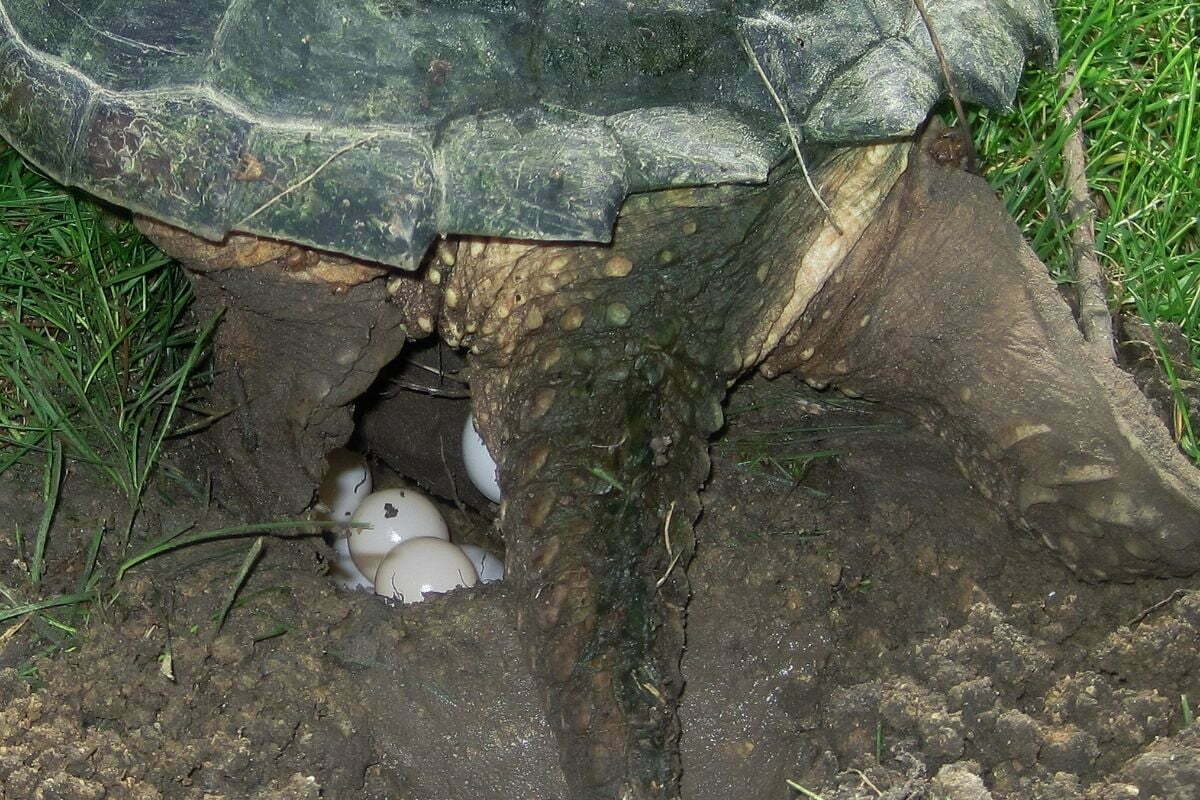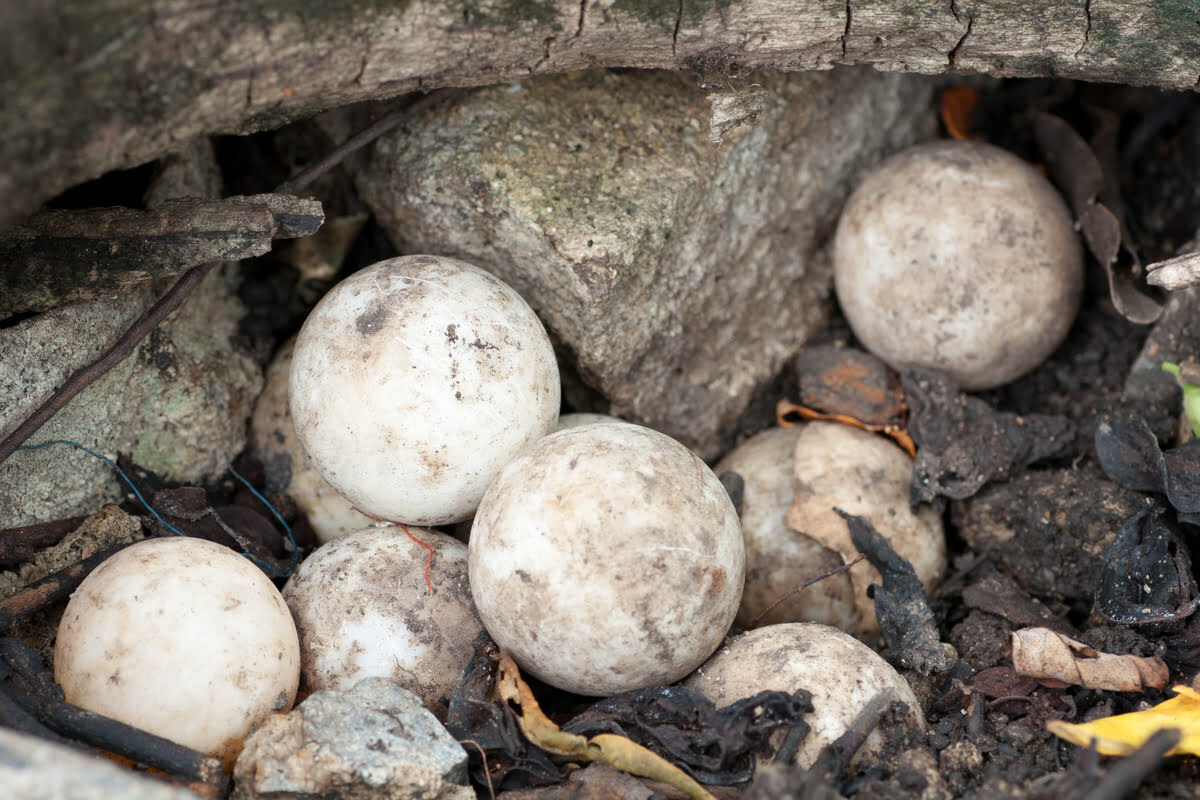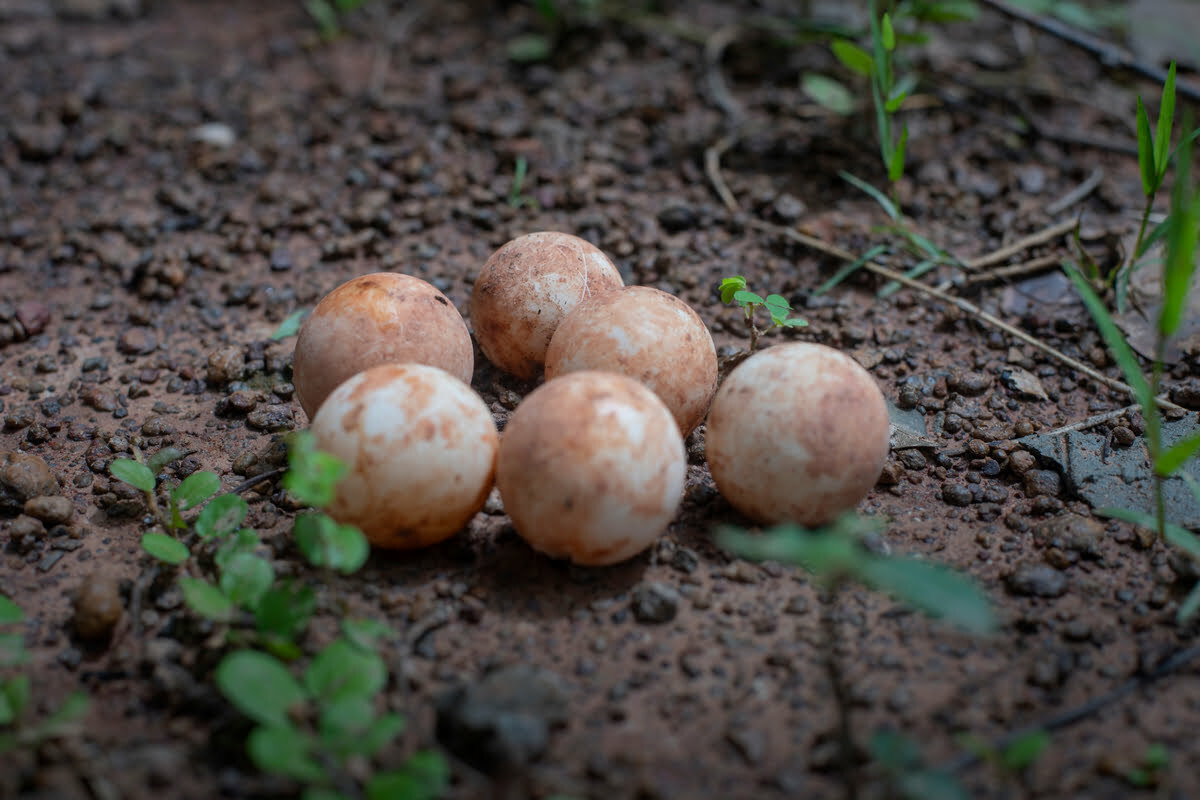A snapping turtle tends to spend a lot of their lives in water, but they do emerge to lay their eggs on land.

Snapping turtles are one of the most common reptiles in North America and can be found throughout much of Canada. They come out of hibernation in springtime and begin laying their eggs in early summer.
The female will typically lay her clutch of up to 30 eggs at a time. She may lay them in a nest made from vegetation, or she may choose an abandoned log hole. But, with burying the eggs, she signals the end of her parental obligation.
If you find a nest, it can be difficult to know what to do to ensure all the eggs are well looked after. We have written this helpful guide for you, so you can ensure all of your actions are ecologically a-ok for snapping turtle hatchlings.
Read on to find out more about snapping turtles and their eggs.
When Are Snapping Turtle Eggs Laid?
Snapping turtles tend to spend a lot of time in the water, and will mate in the water from early spring to fall (about April to October). The mating itself can look very aggressive (a lot of what snapping turtles do is very aggressive).
After mating, it can take three to six weeks before she will lay her first clutch of eggs. Once she is ready to lay her eggs, she’ll dig a shallow pit and cover the area with leaves and other debris. This is where the female will lay her eggs.
Once she lays her eggs, she’ll retreat back into the water to continue her aquatic life – and the eggs are left to fend for themselves in life.
To dig the nest, the female snapping turtle will use her hind legs and flippers to scoop out a hole, about the size and shape of a flask.
The eggs will be laid in this hole, and then covered over with sand, to protect them from the elements and potential predators. The eggs themselves look very similar to ping pong balls.
Snapping turtles, alongside most kinds of turtles, lay quite large clutches of eggs – on average a snapping turtle will lay above 20 eggs.
The number is so high because not all the eggs will be viable, and some will be destroyed before being able to hatch. So, having a large batch of eggs will increase the likelihood of more of the eggs actually hatching.
What Is The Incubation Period For Snapping Turtle Eggs?

Typically, as with a lot of reptilian eggs (which are different from avian eggs, as they aren’t heated by a broody mother bird), the environmental conditions will have a big impact on how long it takes for the eggs to hatch.
Most eggs will hatch between 80 and 90 days after being laid. Usually, if an egg doesn’t hatch in 90 days, it is unviable and won’t hatch.
The incubation period depends on many factors: temperature, humidity, light, and even the age of the mother turtle.
If the temperatures get too hot, the eggs won’t hatch. Interestingly, the incubation temperature has an effect o the offspring – as the hat during incubation will determine the sex of the offspring.
A nest that is in a lower temperature will produce a large yield of female turtles, whereas if there is a higher temperature whilst the eggs are incubating, there will be a larger yield of male snappers once they hatch.
How To Protect A Snapping Turtle Nest
You might find a nest on your property if it is near a water source. Once you have found a nest, it’s important to make sure you don’t disturb the nesting site. It may seem like a good idea to remove the eggs or move the nest, but this could leave the eggs vulnerable to predators.
Snapping turtles have evolved to be excellent at finding safe spots for their nests, and have been known to travel a mile or more to find the best spots to build their nest.
The nests themselves will be deep, in order to conceal the eggs properly. However, as the eggs are just left alone after the mother has laid them (and don’t have an active protector), predators such as wild dogs, raccoons, or mongooses, can unearth the eggs and eat them.
Don’t Touch The Eggs!
If you do find a nest of snapping turtle eggs, the best thing that you can do for the little hatchlings is to leave the nest alone.
Remind to throw dirt back over the eggs if you have uncovered eggs whilst digging through dirt in your garden. They should still continue to develop if you haven’t touched, dislodged, or turned them.
In addition to this, you can work to protect the nest from intruders, by marking the areas that it is in, or setting up a physical barrier (this is particularly important if you are a dog owner, and your four-legged friends are partial to going nosing through the dirt).
Build a cage around the nest so that your animals won’t be able to trample over the nest.
To do this, you can use sticks, thorny branches, chicken wire mesh, or barbed wire. Cover over all sides of the nest, but keep the top open, so that you can see the hatchlings when they start to burrow out of the nest.
You can also use nature to your advantage, too, by planting marigolds or other kinds of plants to keep insects and stray animals from around in the nest.
Once you see one little hatchling above ground, you should see the rest emerge within a day or two. If you have constructed a fence too thoroughly, then the baby turtles won’t be able to escape the confines of the nest to explore their environment.
Once you have taken down the fence so that they can get out, they will be able to find their way to the nearest body of water.
The best time to release your baby turtles from their nest is a rainy evening – and waiting to release them will greatly improve their chances of getting to their destination safely.
How To Move Snapping Turtle Eggs

If you think it is necessary to remove the eggs or have accidentally dug up a nest, you’ll need to carefully pick up the eggs without breaking them, and move them to a safer spot (typically, a prepared incubator that you have set to all the right conditions).
The best way that we can transfer a clutch of eggs is to hold them upright during the transfer from one spot to the next. Ensure all the marks on the eggs face upwards, both whilst transferring and replacing the eggs.
To minimize how much you handle the eggs, we recommend that you set up an incubator before moving them. Replicate the environmental conditions that you found in the original nest, by adding in things such as peat moss and straw.
Spritz the incubator with water so that it stays moist. Maintain the right temperature too – anything above 95 degrees Fahrenheit can cause the eggs to spoil. Ideally, they will be around 84 degrees Fahrenheit.
Once you are ready to move the eggs into their new nest, bear in mind that the eggs are incredibly delicate, and not designed for any kind of motion, so any kind of rough or sudden movement can damage the embryo inside.
The further along in the incubation process the eggs are, the softer and more delicate they will be, as the baby turtles will be eating the eggshell.
As we have already covered, once the first hatchling has appeared, the rest are likely to follow. Science has a reason for this – as biologists have found that hatchlings are able to communicate with each other in the nest before they break out.
They synchronize the moment that they appear, and this increases the likelihood of their survival – the first few days of a baby snapping turtle’s life is the most dangerous.
If hatchlings have started to appear in your incubator – don’t go gung-ho and release them straight away. They still have to absorb the egg yolk sack that is attached to them.
So, you can release them into the wild once they are fully out of their shells, and no longer have an egg yolk sack.
Final Thoughts
In conclusion, if you want to ensure that your baby turtles survive, then you should just avoid ever touching them in the first place – you and your pets are probably the biggest danger to them before they have hatched!
If you think it is unavoidable that you have to move the eggs, then take care when handling them. Prep an incubator to the right conditions, and try to let them hatch as naturally as possible.
We hope that this article has given you a better understanding of what to do (and not do) when you find a clutch of snapping turtle eggs in your yard, or when you are out and about.
